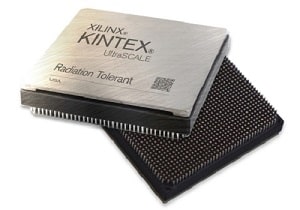- Enables machine learning inference for real time on-board-processing in space
- Delivers full radiation tolerance spanning all orbits
 Xilinx has launched a 20-nanometer (nm) space-grade FPGA, the KintexUltraScale XQRKU060 that delivers full radiation tolerance and ultra-high throughput and bandwidth performance for satellite and space applications. It also provides true unlimited on-orbit reconfiguration, which is a 10x increase in digital signal processing (DSP) performance – ideal for payload applications – and full radiation tolerance across all orbits.
Xilinx has launched a 20-nanometer (nm) space-grade FPGA, the KintexUltraScale XQRKU060 that delivers full radiation tolerance and ultra-high throughput and bandwidth performance for satellite and space applications. It also provides true unlimited on-orbit reconfiguration, which is a 10x increase in digital signal processing (DSP) performance – ideal for payload applications – and full radiation tolerance across all orbits.
The launch of the XQRKU060 for space applications delivers a significant reduction in size, weight and power. It is engineered with robust radiation-tolerant features. The XQRKU060 provides customers with a space-resilient device equipped to handle both short and long duration missions in harsh space environments.
Real-time processing
The XQRKU060 brings high-performance machine learning (ML) to space. A diverse portfolio of ML development tools supporting industry-standard frameworks, including TensorFlow and PyTorch, enable neural network inference acceleration for real-time on-board processing in space with a complete “process and analyze” solution. The XQRKU060’s dense, power-efficient compute with scalable precision and large on-chip memory provides 5.7 tera operations per second (TOPs) of peak INT8 performance optimized for deep learning, a nearly 25x increase compared to the prior generation.
“With our extensive history in developing leading-edge, radiation-tolerant technology and deploying this in reliable space-grade solutions, Xilinx continues its lead with the launch of the world’s most advanced process node for space,” said Minal Sawant, space systems architect, Aerospace and Defense Vertical Marketing, at Xilinx. “The 20nm RT Kintex UltraScale FPGA is breaking industry standards and setting a new benchmark for meeting the high compute requirements of high bandwidth payloads, space exploration and research missions.”
Reconfigurable
The on-orbit reconfiguration capabilities of the XQRKU060 along with real-time on-board processing and ML acceleration, allows satellites to update in real-time, deliver video-on-demand and perform compute “on-the-fly” to process complex algorithms. The ML capabilities are suitable to a variety of problems spanning scientific analysis, object detection, and image classification – such as cloud detection – enabling improved processing efficiency and reduced decision latency both in space and on the ground. As protocols and applications progressively change, the adaptive compute architecture of the XQRKU060 allows unlimited on-orbit reconfiguration to enable customers to perform last-minute product updates before launch, as well as after it has been deployed in orbit.
Resilient for Space
The FPGA offers rich DSP capabilities optimised for dense power-efficient compute. It is equipped with 2,760 UltraScale DSP processors and provides up to 1.6 TeraMACs of signal processing computing, more than a 10x increase compared to the prior generation, as well as dramatic efficiency gains for floating-point computations. The increased compute capability in space is paired with massive I/O bandwidth from 32 high-speed transceivers (SerDes) that can run up to 12.5Gbps to deliver 400Gbps aggregate bandwidth.
“We have baselined Xilinx’s 20nm Kintex UltraScale FPGAs with 12.5 Gbps SerDes links enabling high-throughput, flexible and reconfigurable modulation, demodulation, channelization and routing capability in our newest advanced RF Reconfigurable processor, Wolverine. The Processor leverages the 10x increase in DSP compute capability for direct RF Sampling compared to prior generation systems,” said Paul Rutt, CTO at SEAKR.
The XQRKU060 also features robust 40x40mm ceramic packaging capable of withstanding vibrations and handling during launch as well as radiation effects in harsh orbit environments. The architecture features an innovative design for single event effects (SEE) mitigation thereby meeting the industry requirements for all orbits, including low earth orbit (LEO), medium earth orbit (MEO), geosynchronous orbit (GEO), and deep space missions.
Development Tools
The XQRKU060 brings a new, simplified development environment with the Xilinx Vivado Design Suite. The redesigned routing architecture provides extensive routing capacity to resolve common industry bottleneck challenges. Programming with the Vivado Design Suite helps to eliminate routing congestion, allowing more than 90 per cent of the device to be used without any performance degradation. With Vivado, system designers and radiation teams can maximize productivity and reduce development time, helping to enable aggressive launch schedules.
Additionally, the Vitis unified software platform provides support for embedded software development on the Triple Modular Redundant (TMR)-capable MicroBlaze soft processor. Future extensions will add support for Vitis AI, the Xilinx unified software platform for AI inference on Xilinx devices and production cards.
Availability
A robust ecosystem of compatible solutions for the XQRKU060 is available today. Ecosystem partner solutions offer an array of assets for customers to accelerate their space-application designs, ranging from prototyping boards, space-qualified power, memory and configuration solutions, and single event upsets (SEU) mitigation tools and IP.
Flight units of the 20nm RT Kintex UltraScale space-grade XQRKU060-1CNA1509 FPGA will be available in Xilinx Class B and Class Y test flows per the MIL-PRF-38535, beginning in September of this year. Mechanical samples and prototype units are available now. Customers can start prototyping with the KCU105 Evaluation Kit or the Kintex UltraScale Space Development Kit.










